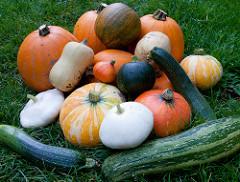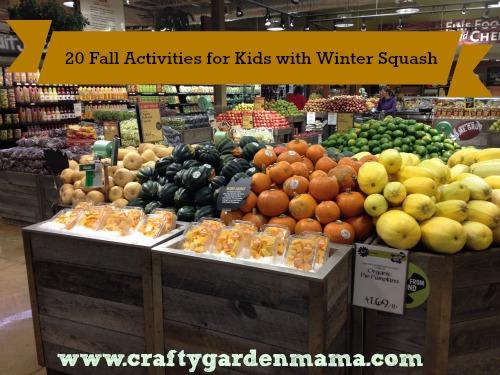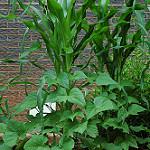
Perhaps no vegetable has a more unappetizing name. But squash is actually an incredibly tasty, versatile and nutritious veggie, that's also fun to grow. And of course there are some fun squash crafts, too.
But first, some squash trivia to get our juices flowing!
1. True or false: there are two kinds of squash: zucchini and pumpkins!
- The Americas
- Western Europe
- Australia
3. True or false: the word squash comes from the french word "tennis played with a small raquet".
See answers below!
Back to those zucchini and pumpkins... Indeed, tasty squash recipes can feel elusive. Sure, who doesn't love a good zucchini bread? But what to do after that? I'll wager some of these tasty concoctions might get your family's lips smacking:
- Butternut Squash Tostada. Simple and tasty, all you need to do is bake or steam your squash, lightly sautee the cooked squash meat (without skin) insome cumin, chili powder and garlic (to taste), pile onto a tortilla, cover in a bit of shredded cheese and broil until cheese is melted.
- Squashy Mac and Cheese. This one is really as simple as it sounds. Steam or bake your squash (any variety of winter squash should work) until it's really soft (and/or puree it), and mix it into pasta with some milk and cheese.
- Julienne it! I have young kids, and have found that presentation is everything. Julienning veggies (i.e. cutting them into thin ribbons) using a handy tool like a Veggetti can make them easy to use and fun to eat. You can go as far as using your ribbons *in place of pasta* in a main dish, or tossing a handful of colorful ribbons into your recipe. I've found that making a decent-sized batch of julienned veggies can last me several days; I'll make fajitas one night, mix them into spaghetti another, etc. I use this technique for summer squashes like zucchini and patty-pan squash, which have thinner / edible skins.
- Squash Soup!! This is my favorite, so I'm giving it an extra exclamation point. Again, squash will cook down, essentially acting like a tasty thickener. I used to make (and eat) variations of this a lot when I lived in West Africa, and here are the basics. 1) Sautee onion and garlic in oil (to taste). Add 2 cups cubed winter squash, 1.5 tsp ginger and 1/2 tsp cumin and cook for a minute or two 2) Add water (or broth), a small can of tomato paste, and some big veggies like carrots and potatoes 3) cook about half an hour, and/or until the veggies are nice and soft. This is great served over rice, or as a hearty stand-alone soup. I tend to just wing this one, but you can find great recipes online like this one on Food.com.
- Pumpkin-pie, old-school: And according to the Library of Congress, pilgrims used to hollow out a pumpkin, fill it with apple, sugar, spices and milk, put the top back on and bake it. Please share photos if you try this; I'm really intrigued!
Note: the biggest difference between winter and summer squash is the skin. Summer squashes are picked younger, when their skins are still edible (think zucchini). Winter squashes - like butternut, pumpkin, etc. - have tougher skins you don't want to try to eat. Notice the recipes above are usually best suited for one or the other.
Yum! With our now (or soon-to-be) full bellies, let's check out some fun ways to get creative with squash.
- Pumpkins: carving, seeds, decomposition. Of course we all know how fun it is to carve pumpkins. From sketching those scary faces to dipping our hands into the slimy guts, this is a great activity for kids. Don't forget that saving and roasting the seeds with a bit of olive oil can make a tasty treat. And save those pumpkins after Halloween! They'll start decomposing in ghoulish heaps, which kids find fascinating to watch. (My kid's school actually props the pumpkins on outside windowsills so the kids can watch them decompose in the weeks after Halloween).
- Squash pals. This year my son had a new friend - Gordy the Blue Pumpkin - who showed up a couple of weeks before Halloween (ahem, I might have had something to do with this). Gordy wrote my son letters, and asked my son to write back with answers and questions. This was a fun way to get my son to practice his reading and writing. I'm not sure he totally believed Gordy was the independent, free-spirited pumpkin he made himself out to be, but he was a good sport and played along! There are just so many varieties of interesting-looking squash that it's easy to create all sorts of friends and characters...
- And check out this great list of writing-focused, science-based and crafty squash ideas from Crafty Garden Mama.
With so much good food and fun to be had, who doesn't want to GROW some squash too? Growing pumpkins, or varieties like butternut or zucchini squash can be really easy. I had several very prolific butternut squash plants grow from seeds thrown in last year's compost!
As it's now late in the season and you're probably doing more "garden planning" than "garden planting", let me plant this proverbial seed: Three Sisters Garden. The Three Sisters Garden originated with the Iroquois, and involves planting corn, beans and squash to maximize their physical and nutrient needs. Corn is a heavy feeder, and beans add lots of nitrogen to the soil. The sprawling and pirckly squash plant in turn deters weeds and pests, and keeps the soil moist. The three form a great symbiotic relationship.
Quiz answers:
1. True and false. There are two main species: Cucurbita maxima or moschata (winter squash) and Cucurbita pepo (summer squash). But there are dozens of varieites within those species, from crookneck squash to pumpkins.
2. Pumpkins originate from northern Argentina, and winter and summer squashes from Mexico and Central America!
3. Uh, false. It's from the Native American word "askutasquash" which means "eaten raw or uncooked". 4. Seeds dating back to 12,000 years ago have been
Sources:
- Texas A&M Extension website
- From the Victory Garden: American history told through squash, Smithsonian website
Photos:
- Squash harvest photo from Tony Austin used under Creative Commons license.
- Three Sisters Garden photo from Abri Le Roux used under Creative Commons license.






The views and opinions expressed in this post are those of the author(s) and do not necessarily reflect those of MomsRising.org.
MomsRising.org strongly encourages our readers to post comments in response to blog posts. We value diversity of opinions and perspectives. Our goals for this space are to be educational, thought-provoking, and respectful. So we actively moderate comments and we reserve the right to edit or remove comments that undermine these goals. Thanks!